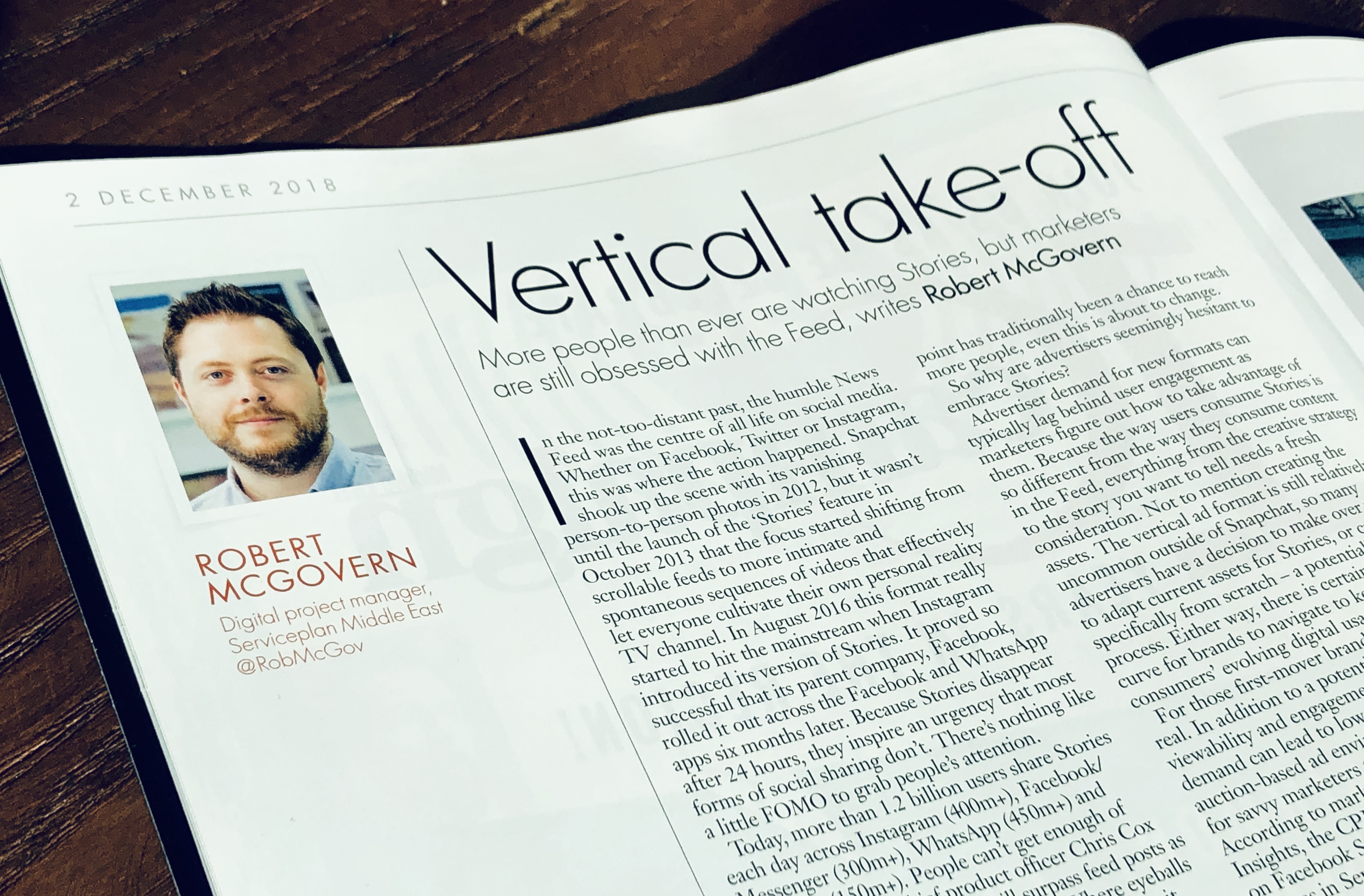More people than ever are watching Stories, but marketers are still obsessed with the Feed.
Originally featured in the December 2nd 2018 issue of Campaign Middle East magazine
In the not-too-distant past, the humble News Feed was the centre of all life on social media. Whether on Facebook, Twitter or Instagram, this was where the action happened. Snapchat shook up the scene with its vanishing person-to-person photos in 2012, but it wasn’t until the launch of the ‘Stories’ feature in October 2013 that the focus started shifting from scrollable feeds to more intimate and spontaneous sequences of videos that effectively let everyone cultivate their own personal reality TV channel. In August 2016 this format really started to hit the mainstream when Instagram introduced its version of Stories. It proved so successful that its parent company, Facebook, rolled it out across the Facebook and WhatsApp apps six months later. Because Stories disappear after 24 hours, they inspire an urgency that most forms of social sharing don’t. There’s nothing like a little FOMO to grab people’s attention.
Today, more than 1.2 billion users share Stories each day across Instagram (400m+), Facebook / Messenger (300m+), WhatsApp (450m+) and Snapchat (150m+). People can’t get enough of them. Facebook Chief Product Officer, Chris Cox has predicted that Stories will surpass feed posts as the top way to share by next year. Where eyeballs go, ad dollars are not usually far behind. But it seems that marketers are a little slow on the uptake in shifting their spend towards Stories from the News Feed. Mark Zuckerberg himself has has attributed some of the parent company’s slowing revenue growth to an explosion in Instagram Stories usage. Basically, proportionately fewer ads are being seen in the Feed because users are spending more time watching Stories, but advertisers haven’t yet made this leap too.
The ads on Stories are hard to ignore because they take over the entire screen of the phone, offering brands a large, interactive canvas to play with. Many brands that have taken the plunge with Stories have reported a higher engagement over Feed ads, seeing users swiping up to learn more about a product when compared to clicking on an ad in the Feed, and generally viewing these ads for longer. While the Feed’s biggest selling point has traditionally been a chance to reach more people, even this is about to change.
So why are advertisers seemingly hesitant to embrace Stories?
Advertiser demand for new formats can typically lag user engagement as marketers figure out how to take advantage of them. Because the way users consume Stories is so different than the way they consume content in the Feed, everything from the creative strategy, to the story you want to tell needs a fresh consideration. Not to mention creating the assets. The vertical ad format is still relatively uncommon outside of Snapchat so many advertisers have a decision to make over whether to adapt current assets for Stories, or create them specifically from scratch – a potentially expensive process. Either way, there is certainly a learning curve for brands to navigate to keep up with consumers’ evolving digital usage.
For those first mover brands, the benefits are real. In addition to a potential boost in viewability and engagement, a lack of initial demand can lead to lower prices in the auction-based ad environment, an opportunity for savvy marketers that are quick to dive in. According to marketing technology company 4C Insights, the CPM (cost per 1,000 impressions) on Facebook Stories, which only rolled out to the masses in September, is currently around 25 per cent cheaper than on the Feed, although this gap is expected to diminish over time.
As more and more platforms embrace Stories, and the vertical ads that go with the territory, it will gradually become more worthwhile for brands to create vertical advertising content. Both Netflix and LinkedIn are planning to introduce Stories-style video formats over the coming months, while YouTube and WhatsApp recently started rolling out vertical video ads within their apps. Similarly, Snapchat have recently launched another new format in the Middle East that features locally produced content, called Shows, which will also host vertical ads.
Facebook itself has been trying to make advertising in Stories simpler by allowing advertisers to easily modify their current assets for the vertical format at the click of a button on Ad Manager, as well as simultaneously rolling them out on Stories across both Instagram and Facebook for maximum reach. To boost uptake, the company has recently launched an initiative to educate SMEs and agencies on the benefits of Stories, a so-called Stories School.
The incredible popularity of the Stories format is even further proof that we are well and truly in an era of visual communication and Facebook knows how important it is to get ads on Stories right. Mark Zuckerberg admitted as much back in April – “one of the interesting opportunities and challenges over the coming years will be making sure that ads are as good in Stories as they are in Feeds. If we don’t do this well, then as more sharing shifts to Stories, that could hurt our business”. With Facebook’s platforms accounting for over 1 billion of the more than 1.2 billion daily Stories users, they sure have more skin in the game than most.


